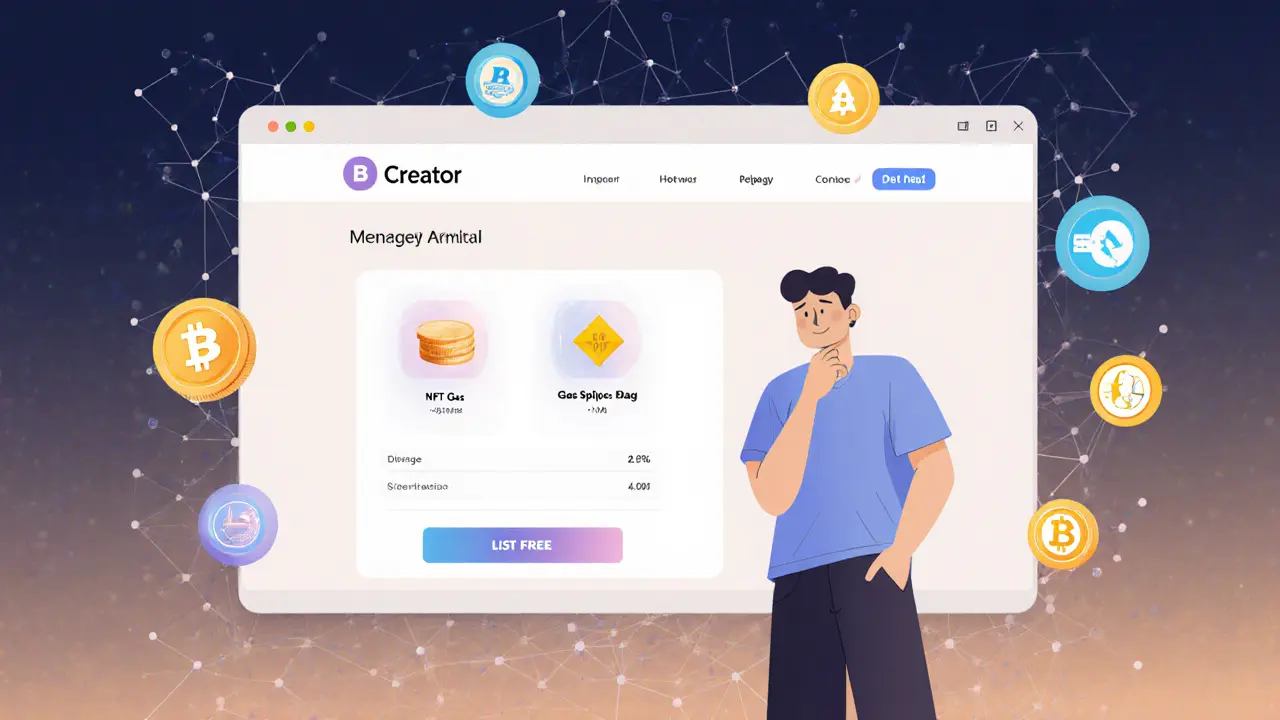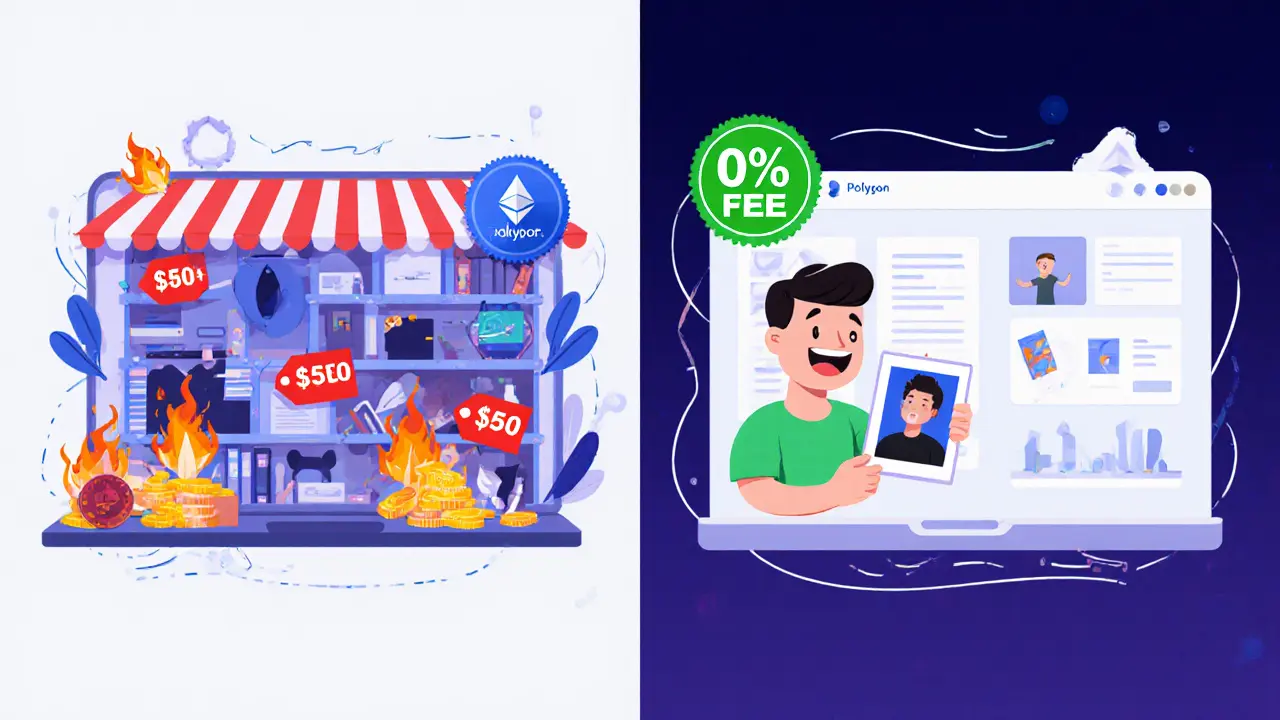NFT Marketplace Fees and Costs: What You Really Pay to Buy, Sell, and Build in 2025
 Apr, 11 2025
Apr, 11 2025
NFT Marketplace Fee Calculator
Calculate Your NFT Transaction Costs
Cost Breakdown
Buying an NFT isn’t just about the price tag on the artwork. There’s a hidden layer of fees - from listing charges to gas costs - that can eat into your profits before you even click "Buy." And if you’re thinking of building your own NFT marketplace, the upfront costs might shock you. By 2025, the real cost of NFTs isn’t just what you pay at checkout. It’s what you pay to get there, what you pay to stay there, and what you pay to even enter the game.
How Much Does It Cost to Build an NFT Marketplace?
Building an NFT marketplace from scratch isn’t like launching a Shopify store. You’re not just picking a theme and adding products. You’re coding smart contracts, securing blockchain infrastructure, and designing a system that handles digital ownership across decentralized networks. The cost? It ranges from $30,000 to over $250,000, depending on what you need.
A basic MVP - think simple listing, wallet connection, and one-chain support - can be done for around $40,000. That’s the bare minimum. But if you want cross-chain compatibility, automated royalties, real-time analytics, or a launchpad for creators, you’re looking at $150,000 to $250,000. Companies like Cubix and Perimattic offer tiered packages that reflect this split. The cheaper options skip features like multi-wallet support or advanced security audits. The expensive ones include them - and they matter.
Here’s how that money breaks down:
- Development team: $10,000-$100,000 (depends on location and experience)
- Smart contract development: $5,000-$50,000 (critical - one bug can cost millions)
- UI/UX design: $3,000-$30,000 (users won’t stick around if it’s clunky)
- Decentralized storage (IPFS/Arweave): $3,000-$30,000 (your NFTs need to live somewhere permanent)
- Security audits: $5,000-$50,000 (non-negotiable - 32% of platforms have exploitable flaws)
- Maintenance: $4,000-$6,000 per month (updates, bugs, scaling)
And don’t forget infrastructure. Running a node on Ethereum or Polygon costs $500-$2,500 monthly. Add quarterly updates, performance tuning, and bug fixes - that’s another $2,000-$5,000 every three months. Most new operators think they’re done after launch. They’re not. Perimattic found that 78% of failed marketplaces underestimated maintenance costs by 300-400%.
What Fees Do Users Actually Pay When Trading NFTs?
Once your marketplace is live, users start trading. That’s when the real fees kick in - and they vary wildly by platform.
Transaction fees (platform commission): This is the fee the marketplace takes from each sale. OpenSea and Rarible charge 2.5%. SuperRare charges 3%. But newer platforms are changing the game. NFTrade charges 0%. TofuNFT charges 5%. PlayDapp and Refinable stick with 2.5%. The trend? Lower fees attract more creators - and more buyers. Wildnet Edge found that fees above 5% deter up to 63% of potential buyers.
Royalty fees: Creators set these - usually 5% to 10% - and get paid every time their NFT resells. But here’s the catch: not all marketplaces honor them. OpenSea stopped enforcing creator royalties on secondary sales in 2023, sparking backlash. Platforms like SuperRare and Cubix-built marketplaces still enforce them automatically. If you’re a creator, this matters. If you’re a buyer, it means you’re paying more - but the artist gets paid too.
Listing fees: Some platforms charge you just to put an NFT up for sale. On OpenSea? Free. On some niche platforms? $1 to $200 per listing. One marketplace charged $150 per listing. Result? 89% of creators abandoned it within 90 days.
Bidding fees: If your auction includes bidding, expect 1% to 3% of the final bid. On a $5,000 NFT, that’s $50-$150 in fees before the sale even closes.
And then there’s the elephant in the room: gas fees. On Ethereum, gas can spike from $50 to over $500 during peak times. That’s not a platform fee - it’s a blockchain fee. And it’s why Polygon-based marketplaces are exploding. Polygon gas fees average under $0.01. For micro-transactions - like selling a $10 digital collectible - Ethereum is dead. Polygon is the only viable option.
Why Some Platforms Succeed and Others Die
It’s not about having the fanciest interface. It’s about fee structure.
Cubix built a marketplace that hit 15,000 active users in six months. How? Tiered fees: 0% for the first 100 listings, then 1.5%. That’s a sweet spot - low enough to attract new creators, high enough to cover costs. Compare that to a platform charging $150 per listing. No creator can afford that unless they’re selling $10,000 NFTs daily.
Platforms that fail usually do one of three things:
- Charge too much upfront (listing fees over $50)
- Ignore gas fees and force users onto Ethereum
- Don’t enforce royalties, so creators leave for platforms that do
Meanwhile, successful platforms focus on three things: transparency, flexibility, and automation. Users don’t mind paying fees if they know exactly what they’re paying for. They hate surprise charges. They love platforms that handle royalties automatically. They hate having to manually track them across chains.
And here’s a hidden truth: the best platforms don’t just charge fees - they offer value. Cubix’s platforms include built-in analytics that show creators which NFTs are trending. Perimattic added Polygon ID for verified creator profiles. These features keep users engaged - and that’s what turns a marketplace into a community.

Which Blockchain Should You Choose? Ethereum vs. Polygon vs. Solana
Not all NFT marketplaces run on the same blockchain. The choice changes everything - especially cost.
Ethereum: The original. High visibility. High fees. Gas can hit $500 during NFT drops. Best for high-value art and collectors who don’t mind paying. But for anything under $100? Forget it. Alchemy warns Ethereum is unsuitable for micro-transactions.
Polygon: The rising star. Near-zero gas fees. 67% annual growth. Platforms like NFTrade, TofuNFT, and Refinable are built here. Perfect for gamers, musicians, and indie creators. 42% of users drop off from Polygon marketplaces during Ethereum congestion - because they’re used to instant, cheap transactions. But Polygon’s low cost makes it the default for new entrants.
Solana: Fast, cheap, and volatile. Fees under $0.01. But it’s had network outages. Still, platforms like Tensor and Magic Eden thrive here. Great for high-frequency trading. Less trusted for long-term art collection.
Top platforms now support multiple chains. But if you’re starting out? Go with Polygon. It’s the most beginner-friendly, cost-efficient, and user-attracting option in 2025.
Regulation, Security, and the Hidden Risks
2025 is the year regulation catches up. The SEC now requires marketplaces to determine whether an NFT qualifies as a security. About 18.3% of listed NFTs are now under review. That means platforms must add compliance checks - which adds cost and complexity.
Security is another silent killer. Smart contract bugs have led to millions in losses. Always audit your contracts. Third-party audits cost $5,000-$15,000 - but skipping them is like leaving your front door open. Cubix’s security report found 32% of platforms had exploitable vulnerabilities.
And then there’s the learning curve. Building an NFT marketplace requires Solidity (for Ethereum), Rust (for Solana), and deep knowledge of ERC-721 and ERC-1155 standards. Most teams take 6-9 months to get proficient. If you’re outsourcing, ask for proof of past work. Look at GitHub stars. Check Discord communities. Cubix has 8,500+ members. Perimattic has 4,200+. Those numbers mean support exists.

What’s Next? The Future of NFT Marketplace Fees
By late 2025, we’ll see AI-powered pricing assistants - tools that suggest optimal listing prices based on past sales. Cross-chain instant settlement will let you sell an Ethereum NFT and get paid in Polygon tokens - no swapping needed. Regulatory modules will auto-flag potentially illegal NFTs.
But here’s the real shift: specialization. The days of one-size-fits-all marketplaces are ending. Art-focused platforms will thrive. Gaming NFTs will have their own ecosystems. Music NFTs will bundle royalties with streaming rights. Gartner predicts 35% of small marketplaces will vanish by 2026 - replaced by niche, high-value platforms.
The winners? Those who keep fees low, automate everything, and build trust. The losers? Those who think they can charge $200 to list a $10 NFT and still survive.
Final Takeaway: Fees Are the Real Barrier to Entry
If you’re a buyer: Look for platforms with 0-2.5% fees and Polygon support. Avoid anything with listing charges over $10.
If you’re a creator: Choose platforms that enforce royalties. Check their documentation. Join their Discord. Make sure they’ve been audited.
If you’re building a marketplace: Start lean. Use Polygon. Charge 0-1.5% on sales. Don’t charge listing fees. Budget for maintenance - not just launch. And never skip the security audit.
NFT marketplaces aren’t about hype anymore. They’re about sustainability. The fees you choose today will determine whether your platform survives the next bear market - or disappears with the rest of the noise.
What are the typical fees on OpenSea in 2025?
OpenSea charges a flat 2.5% fee on all final sale prices, whether the NFT is traded on Ethereum or Polygon. There are no listing fees. However, users still pay Ethereum gas fees during high-traffic periods, which can range from $50 to over $500. Polygon transactions on OpenSea have near-zero gas costs, making them far more affordable for smaller sales.
Can I create an NFT marketplace for free?
No, you cannot build a real, secure, and scalable NFT marketplace for free. While there are no-code templates and clones available for under $5,000, these lack security audits, custom smart contracts, and reliable infrastructure. A functional, safe platform requires development teams, blockchain integration, storage solutions, and ongoing maintenance - totaling at least $30,000. Free options are either non-functional, insecure, or violate blockchain standards.
Why do some NFT marketplaces charge 0% fees?
Marketplaces like NFTrade charge 0% to attract creators and users quickly. They make money through other means - like premium features (e.g., promoted listings, analytics dashboards), staking rewards, or token sales. This strategy works because low friction brings volume, and volume creates opportunity for alternative revenue. It’s a trade-off: lower immediate income for faster growth.
Are NFT marketplace fees regulated?
Fees themselves aren’t regulated, but the NFTs being sold are. As of February 2025, the SEC requires marketplaces to assess whether an NFT qualifies as a security. If it does, the platform must comply with federal securities laws - which may include restricting sales, verifying buyer identities, or halting trading. This affects about 18.3% of listed NFTs. Fee structures aren’t controlled, but compliance costs are rising.
Which is cheaper: Ethereum or Polygon for NFT trading?
Polygon is dramatically cheaper. Ethereum gas fees average $50-$150 during normal times and can spike over $500 during popular drops. Polygon gas fees are typically under $0.01. For any NFT under $500, Polygon is the only practical choice. Ethereum remains relevant for high-value art and collectors who prioritize network prestige over cost.
Do I have to pay fees every time I list an NFT?
Not always. OpenSea, Rarible, and Polygon-based platforms like NFTrade allow free listing. But some niche or premium marketplaces charge $1-$200 per listing. Always check the platform’s fee schedule before uploading. High listing fees are a red flag - they often lead to creator abandonment, as seen in platforms charging $150+ per listing.
How do royalty fees work on NFT marketplaces?
Royalty fees are set by the original creator - usually 5% to 10% - and are paid to them every time the NFT is resold. Not all platforms enforce them. OpenSea stopped enforcing royalties on secondary sales in 2023. Platforms like SuperRare and Cubix-built marketplaces still do. If you’re a creator, choose a platform that enforces royalties. If you’re a buyer, understand that a higher price may mean the artist still gets paid.
What’s the biggest mistake people make when launching an NFT marketplace?
Underestimating ongoing costs. Most founders focus on the upfront development cost - $40,000 to $150,000 - but forget about monthly maintenance ($4,000-$6,000), quarterly updates ($2,000-$5,000), security patches, and customer support. Perimattic’s data shows 68% of failed marketplaces collapsed because they ran out of money after launch. Budget for at least 12 months of operations before you even launch.
Jane A
November 23, 2025 AT 13:25This whole article is just a fancy way of saying 'NFTs are a scam unless you're rich.' I've seen people spend $500 on gas just to list a JPEG of a monkey. Who even cares anymore? The whole thing is a pyramid scheme with better graphics.
Gus Mitchener
November 24, 2025 AT 07:41The ontological burden of NFT infrastructure is non-trivial when considering the meta-ontological framework of decentralized ownership economies. The gas fee asymmetry between Ethereum and Polygon isn't merely a technical variable-it's a epistemic rupture in the transactional phenomenology of digital scarcity. Smart contract audits aren't cost centers; they're hermeneutic safeguards against ontological collapse in the post-blockchain hermeneutic circle.